The Special Night Event at the Kabukiza Theatre returns for the third year as the highlight of TIFF’s Japanese Classics section.
This year, we will showcase the Japanese classic Chûshingura in a digitally remastered version and Blood’s Up at Takata-no-Baba with the accompaniment of benshi narration, a tradition of live narration for silent films. There will also be an enchanting performance by Kabuki actor Onoe Kikunosuke in the onnagata (female role) dance masterpiece “Sagi Musume (Heron Maiden)”.
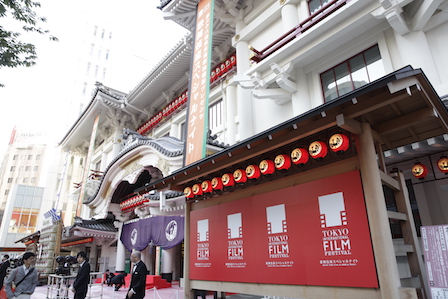
■Date: October 27 (Thu) Doors opening: 4:30 p.m. / Show starting: 5:30 p.m.
■Dress Code: Business Casual
■Program: “Sagi Musume (Heron Maiden)” (produced by SHOCHIKU)
■Special Screening: Chûshingura (Digitally Remastered), Blood‘s Up at Takata-no-Baba (Chikemuri Takata-no-Baba)
Kabuki actor, Onoe Kikunosuke in the Enchanting Onnagata Masterpiece “Sagi Musume (Heron Maiden)”
Onoe Kikunosuke
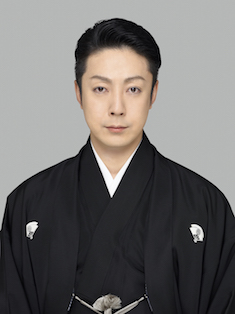
Profile:
Onoe Kikunosuke was born the eldest son of Onoe Kikugoro VII in 1977. In 1984, he debuted at the Kabukiza Theatre under the name Onoe Ushinosuke VI in “Ehon Ushiwakamaru”, playing Ushiwakamaru. In 1996, he took the stage name Onoe Kikunosuke V, appearing in the role of Benten Kozo Kikunosuke in “Shiranami Gonin Otoko”, and in the double role of Kosho Yayoi and the spirit of the shishi lion in “Kagami Jishi”. In recent years, he has proven popular in both onnagata (female roles) and tachiyaku (male roles), appearing as Masaoka in “Meiboku Sendai Hagi”, a role portrayed by both his grandfather and father before him. He also enacted Tamate Gozen in “Sesshu Gappo ga Tsuji”, Enya Hangan in “Kanadehon Chūshingura”, and Tadanobu Kitsune in “Yoshitsune Senbon Zakura”, a famed Kyogen piece (short farces presented between Noh acts) that is connected with his family. He has frequently performed overseas, in such plays as “NINAGAWA Twelfth Night (NINAGAWA Juuni-ya)”, directed by Yukio Ninagawa at London’s Barbican in 2009, and “Kagami Jishi” at the Japan-China Friendship Kyogeki and Kabuki performance in Beijing in 2015. He has also appeared in films such as Murder of the Inugami Clan (2006), directed by Kon Ichikawa, Kaidan or A Ghost Story (2007), directed by Hideo Nakata, and was a voice actor in the Japanese-dubbed version of The Chronicles of Narnia.
Comment:
I am very pleased to have this opportunity to perform at the Special Night Event at Kabukiza Theatre, for the prestigious Tokyo International Film Festival. I am going to perform “Sagi Musume (Heron Maiden)”, which is a very popular Kabuki dance program. For its third edition, this event is spotlighting an onnagata (female role) performance for the first time. As there are no real women on the Kabuki stage, onnagatas are one of the remarkable features of Kabuki and I am really looking forward to seeing the reaction of audiences from both Japan and abroad. “Sagi Musume” is a well-known program overseas, due to the universality of its theme — a maiden’s tragic love — which most people can understand easily. It is also visually stunning, with the transformation of a girl wearing a pure white kimono and white hood into the belle of the town and finally, into the spirit of the heron. The scenography also creates a fantastical world, matching a rich and varied melody.
I hope everyone will enjoy the program and have a memorable evening at the Kabukiza Theatre.
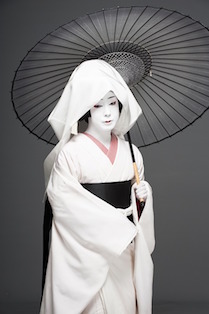
Sagi Musume (Heron Maiden) Overview
This is one of the greatest dance pieces performed by actors portraying onnagata female roles in Kabuki. As the curtain rises, a young woman in a pure white kimono stands idle by the side of a pond in a constant snowfall. She is, in fact, the spirit of a heron in human form. She expresses in her dance her torment at falling in love with a human, which is forbidden. A quick costume change or hikinuki, when the top layer of kimono is pulled away revealing the next layer, transforms her into the belle of the town. She reminisces about the time when she was with a man and dances seductively, the first highlight of this piece. This progresses onto Teodori — dance with hand gestures — along to then-popular music, where she laments the coldness of the man. Another quick costume change sees the lone maiden in a vibrant dancing scene joined by a group of performers with umbrellas. Gradually, her torturous feelings of forbidden love take their toll and the true nature of the heron’s spirit is revealed. As the snow continues to fall, the heron unfurls her wings in anguish and this iconic dance serves as the final act. A rich and varied storyline along with a wealth of traditional Kabuki techniques such as hikinuki make this a hugely popular piece.
Masterworks from Early Showa Era to Be Screened with Benshi Narration
<Chûshingura (Digital Longest Version)
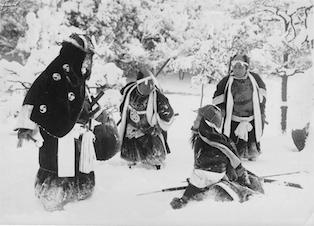
Director:Tomiyasu Ikeda
Cast:Matsunosuke Onoe, Kaichi Yamamoto, Takeo Katsura, Yoneko Sakai
Year: 1926
Film provided by: Toy Film Museum
“Chûshingura” is a famous story of revenge known to every Japanese. This epic 1926 film starred Onoe Matsunosuke Onoe, Japan’s first movie star, who appeared in over 1,000 films in his short lifetime. The specific military formations and tactical organizational maneuvers in the film are based on extensive research of historical documents, setting the standard for the many subsequent productions of Chûshingura.
Storyline: Takuminokami Asano, the lord of the Akō Domain, loses patience after being repeatedly insulted by Kōzukenosuke Kira and stabs him in the corridor of the Edo Castle. For this, Takuminokami is ordered to commit harakiri (suicide by disembowelment) and the Asano family is discontinued. But the samurai retainers of the Asano family quietly wait for an opportunity to avenge their deceased lord. Chief Retainer Kuranosuke Ōishi pretends to indulge in debauchery day and night to deceive the Kiras, who fear their enemy’s vengeance. Finally, on December 14, 1702, Ōishi leads a group of Akō’s masterless samurai to launch an attack on the Kira residence. The samurais’ wish to avenge their master is finally fulfilled.
Blood’s Up at Takata-no-Baba (Chikemuri Takata-no-Baba)
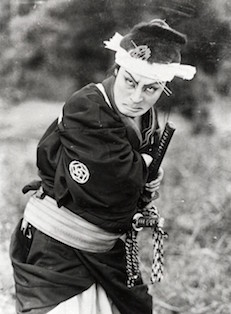
Director: Daisuke Ito
Cast: Denjiro Okochi
Year: 1928
Popular TV personality Ichiro Furutachi to be appointed as a guest benshi narrator for our Special Night Event at Kabukiza Theatre!
This film was originally released in 1928 in 11 episodes, but little more than one episode’s worth of the work remains today. Yet, even within the confines of the remaining scenes, this masterpiece emanates with the unbounded youth and vigor of director Daisuke Itō and star Denjirō Ōkōchi, who heralded a new era of Japanese silent film.
Storyline: In spring 1694, Yasubei Nakayama is a masterless samurai in Hatchobori, earning his living by settling quarrels. Ashamed of his self-indulgent drinking life, he grabs his precious sword and dashes to his uncle’s aid one night. But when he arrives at Takata-no- Baba, he finds his uncle taking his last breath. In a fury, Yasubei slashes through 18 opponents, admirably avenging his uncle’s death on the spot.